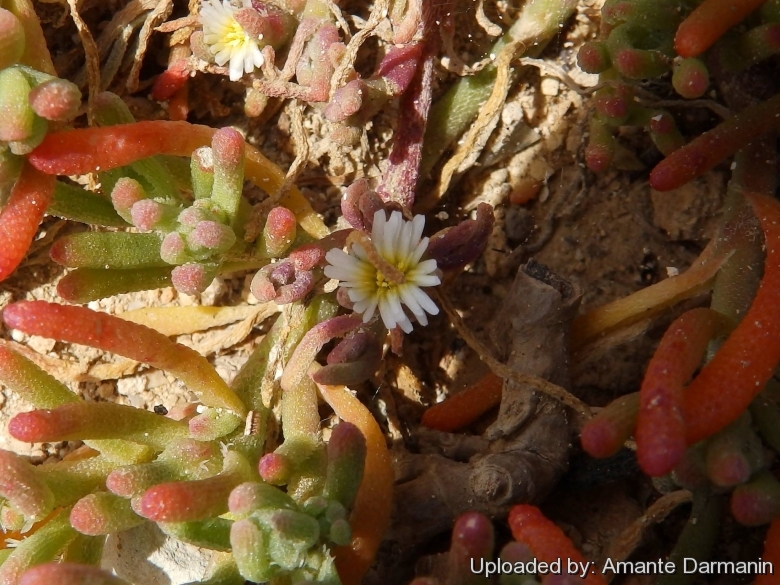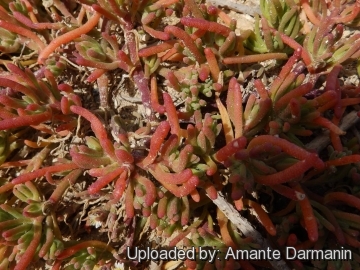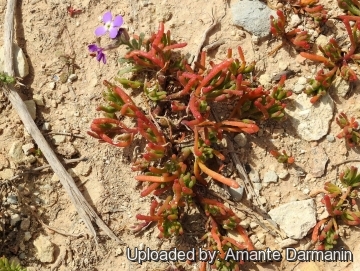Accepted Scientific Name: Mesembryanthemum nodiflorum L.
Sp. Pl. 480 1753. L.

Gasoul nodiflorum (Mesembryanthemum nodiflorum) Photo by: Amante Darmanin
Lesser crystal ice-plant, Kristalina tal-blat. Delimara, Malta, 10/03/2017.
Origin and Habitat: Mesembryanthemum nodiflorumSN|33913]]SN|33913]] comes from southern Africa (Northern Cape, Western Cape) and Namibia but it is known in many other places as an introduced species and sometimes an invasive weed, including several regions of Europe (Mediterranean), Canary Islands, North Africa, Israel, Jordan, Arabia and Iran as also endemic to Asia, Australia, parts of the western United States (California to Arizona and New Jersey) and adjacent Mexico (Baja California), and some Atlantic islands.
Altitude range: 0-100 metres above sea level.
Habitat and ecology: This dwarf succulent may form dense colonies, with near continuous cover, in coastal bluffs, ground along the seashore and margins of saline wetlands. It is also common on disturbed places and along roadsides, mainly in winter rainfall areas. The foliage often takes on an overall reddish colour, particularly under drying conditions. Locally frequent.
Synonyms:
See all synonyms of Mesembryanthemum nodiflorum
Common Names include:
ENGLISH: Lesser crystal ice-plant, Slender-leaved iceplant, slenderleaf iceplant, slender-leaf iceplant
AFRIKAANS (Afrikaans): brakslaai
ARABIC ( لعربية ): سبيب عاري الأزهار
GERMAN (Deutsch): Knotenblütige Mittagsblume
ITALIAN (Italiano): erba cristallina stretta
MALTESE (Malti): Kristalina tal-blat
PERSIAN (فارسی): گل نیمروز
SPANISH (Español): yerba del vidrio, gulluricos, cañutillo, algazul, aiguazul, aguazul, agazul, gazul, cosco, Algazul, cofe-cofe
Description: Mesembryanthemum nodiflorumSN|33913]]SN|33913]] is a succulent plant in the ice plant family known by the common name slender-leaf iceplant. This is a usually annual herb (terophyte) forming a mostly prostrate clump or mat of stems up to about 20 centimeters in maximum length, without a basal vegetative rosette. The small stem branches are lined with knob-like cylindrical fleshy leaves up to 2 centimetres long. The herbage is glaucous-green to bright red and visibly covered with colourless shining, bubble-like papillae (large, white, glistening bladder cells or water vesicles). The flowers are solitary or borne in loose clusters. Each is about half a centimeter wide with many narrow to thready white or pale yellow petals. The fruit is a capsule which opens when it becomes wet, releasing seeds.
Derivation of specific name: Nodiflorum, Latin nodus (node), and florus (flower), in reference to the flowers that arise from the nodes of the stems.
Stems: Prostrate to ascending, slender, very branched from base, rarely over 3 mm in diameter 2-22 cm long, fleshy.
Leaves: Sessile, alternating opposite and superior basal, blade, almost cylindrical or slightly channelled, linear, 1-2(-4) cm long and 1-2 mm wide, obtuse at apex, slightly narrowed toward base. Papillose with enlarged central water-storing cells, bladder cells 1-1 .5 mm in diameter, crystalline, rounded, usually ciliate along the basal parts of the leaf margins.
Inflorescences: Subsessile or short-pedicellate and solitary in axil, sessile or petiolate (pedicel short), equal, green at first and purple at maturity; bracts absent.
Flowers: White or pale yellow 4-5(-10) mm in diameter. Hypanthium obconic. Calyx lobes (sepals) 4- or 5, equal or uneven, succulent and papillose. Tube broadly campanulate 4-6 mm long, obtusely ribbed. Petals 20, approximately the same size as sepals, fused at base, white or pale pink or white with pale pink tips, ageing yellow, free, filamentous staminodes absent, petals and stamens very few, nectaries tubular, stigmas whitish to yellow. Stamens 10. Anthers yellow.
Blooming season: Flowering spring-fall.
Fruits (capsules): Obovoid, somewhat pentagonal or pyramidal at apex, 5-6 mm high, finely papillate, valves 5, valve wings rel flexed and fused in pairs, tardily dehiscent by terminal pores or splits.
Seeds: About 100, 0.8-1 by 0.5-0.6 mm, triangular or semicircular, somewhat compressed, whitish to brownish-red, smooth to minutely tuberculate.
Chromosome number: 2n = 36.
Bibliography: Major references and further lectures
1) Heidrun E.K. Hartmann “Illustrated Handbook of Succulent Plants: Aizoaceae F-Z” Springer Science & Business Media, 2002
2) “Mesembryanthemum nodiflorum Linnaeus, Sp. Pl. 1: 480. 1753. Slender-leaved iceplant” in Flora of North America @ efloras.org <http://www.efloras.org/florataxon.aspx?flora_id=1&taxon_id=242415132> FNA Vol. 4 Page 76, 84, 85
3) Wikipedia contributors. "Mesembryanthemum nodiflorum." Wikipedia, The Free Encyclopedia. Wikipedia, The Free Encyclopedia, 3 Feb. 2017. Web. 22 Mar. 2017.
4) Nancy J. Vivrette Mesembryanthemum nodiflorum in :"MESEMBRYANTHEMUM
ICEPLANT", University of California web: http://ucjeps.berkeley.edu/cgi-bin/get_JM_treatment.pl?265,281,283
5) Goldblatt, P. and Manning, J.C. Cape Plants "A conspectus of the Cape Flora of South Africa". Strelitzia 9. National Botanical Institute, Cape Town. 2000.
6) Raimondo, D., von Staden, L., Foden, W., Victor, J.E., Helme, N.A., Turner, R.C., Kamundi, D.A. and Manyama, P.A. 2009. "Red List of South African Plants". Strelitzia 25. South African National Biodiversity Institute, Pretoria.
7) Burgoyne, P.M. 2006. Mesembryanthemum nodiflorum L. National Assessment: Red List of South African Plants version 2017.1. Accessed on 2017/03/22
8) Ingrid Schönfelder, Peter Schönfelder “Kosmos Atlas Mittelmeer- und Kanarenflora.” Über 1600 Pflanzenarten. 2. Auflage. Franckh-Kosmos, Stuttgart 2002.
9) Adalbert Hohenester, Walter Welss “Exkursionsflora für die Kanarischen Inseln. Mit Ausblicken auf ganz Makaronesien.” Eugen Ulmer, Stuttgart (Hohenheim) 1993.
10) Valdés B., Talavera S., y Fernández-Galiano E. “Mesembryanthemum nodiflorum L.” (Ed. Ketres) Flora Vascular de Andalucía Occidental
11) S. Castroviejo. Mesembryanthemum nodiflorum L. (Real Jardín Botánico) Castroviejo y al (eds.), “Flora ibérica” Vol. 2, Pag. 80
12) Le Roy Abrams, Roxana Stinchfield Ferris “An Illustrated Flora of the Pacific States: Polygonaceae to Krameriaceae, buckwheats to kramerias” Stanford University Press, 1923
13) Forrest Shreve, Ira Loren Wiggins “Vegetation and Flora of the Sonoran Desert”, Volume 1 Stanford University Press, 1964
 Mesembryanthemum nodiflorum, Delimara, Malta. 10/3/17 (Mesembryanthemum nodiflorum) Photo by: Amante Darmanin
Mesembryanthemum nodiflorum, Delimara, Malta. 10/3/17 (Mesembryanthemum nodiflorum) Photo by: Amante Darmanin Mesembryanthemum nodiflorum, Delimara, Malta. 10/3/17 (Mesembryanthemum nodiflorum) Photo by: Amante Darmanin
Mesembryanthemum nodiflorum, Delimara, Malta. 10/3/17 (Mesembryanthemum nodiflorum) Photo by: Amante DarmaninCultivation and Propagation: Mesembryanthemum nodiflorumSN|33913]]SN|33913]] is occasionally cultivated. It is easily grown.
Soil: It grows well in an ordinary well-drained garden soil but thrives in a wide range of soil comprising light (sandy), medium (loamy) and heavy (clay) soils, prefers well-drained soil and can grow in nutritionally poor soil. Suitable for both acid, neutral and basic (alkaline) soils and can grow in saline soils so long as it is in a sunny position.
Light requirements: It cannot grow in the shade.
Hardiness: It is not very hardy and will be killed even by a light frost. It is, therefore, usually grown as a half-hardy annual, being sown in a greenhouse in the spring and used for summer bedding.
Pest and diseases: Plants have few problems with pests or diseases though the young plants are prone to root rot and damping off unless given plenty of ventilation and dry growing conditions.
Propagation: Seed - sow spring in a greenhouse, only just covering the seed. When they are large enough to handle, prick the seedlings out into individual pots and plant them out after the last expected frosts. Seedlings are prone to damp off so should not be over watered and should be kept in a very sunny well-ventilated position












